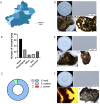Identification of Mycoviruses in the Pathogens of Fragrant Pear Valsa Canker from Xinjiang in China
- PMID: 38543721
- PMCID: PMC10974596
- DOI: 10.3390/v16030355
Identification of Mycoviruses in the Pathogens of Fragrant Pear Valsa Canker from Xinjiang in China
Abstract
As a common disease, canker seriously affects the yield and quality of fragrant pear due to the lack of effective control measures. Some fungi have been reported to harbor rich reservoirs of viral resources, and some mycoviruses can be used as biocontrol agents against plant diseases. In this study, 199 isolates were obtained from diseased branches of fragrant pear in the main production areas of Xinjiang. Among them, 134 belonged to Valsa spp., identified using morphological and molecular biological techniques, in which V. mali was the dominant species. The mycoviruses in Valsa spp. were further identified using metatranscriptomic sequencing and RT-PCR. The results revealed that a total of seven mycoviruses were identified, belonging to Botourmiaviridae, Endornaviridae, Fusariviridae, Hypoviridae, Mitoviridae, and Narnaviridae, among which Phomopsis longicolla hypovirus (PlHV) was dominant in all the sample collection regions. The Cryphonectria hypovirus 3-XJ1 (CHV3-XJ1), Botourmiaviridae sp.-XJ1 (BVsp-XJ1), and Fusariviridae sp.-XJ1 (Fvsp-XJ1) were new mycoviruses discovered within the Valsa spp. More importantly, compared with those in the virus-free Valsa spp. strain, the growth rate and virulence of the VN-5 strain co-infected with PlHV and CHV3-XJ1 were reduced by 59% and 75%, respectively, and the growth rate and virulence of the VN-34 strain infected with PlHV were reduced by 42% and 55%, respectively. On the other hand, the horizontal transmission efficiency of PlHV decreased when PlHV was co-infected with CHV3-XJ1, indicating that PlHV and CHV3-XJ1 were antagonistic. In summary, the mycoviruses in Valsa spp. were identified in Xinjiang for the first time, and three of them were newly discovered mycoviruses, with two strains yielding good results. These results will offer potential biocontrol resources for managing pear canker disease and provide a theoretical basis for the control of fruit tree Valsa canker disease.
Keywords: Valsa spp.; biocontrol; fragrant pear canker disease; metatranscriptomics; mycovirus.
Conflict of interest statement
The authors declare no conflicts of interest.
Figures





Similar articles
-
Exploration of the Biocontrol Activity of Bacillus atrophaeus Strain HF1 against Pear Valsa Canker Caused by Valsa pyri.Int J Mol Sci. 2023 Oct 23;24(20):15477. doi: 10.3390/ijms242015477. Int J Mol Sci. 2023. PMID: 37895155 Free PMC article.
-
Identification of Diverse Mycoviruses through Metatranscriptomics Characterization of the Viromes of Five Major Fungal Plant Pathogens.J Virol. 2016 Jul 11;90(15):6846-6863. doi: 10.1128/JVI.00357-16. Print 2016 Aug 1. J Virol. 2016. PMID: 27194764 Free PMC article.
-
Infection of Two Heterologous Mycoviruses Reduces the Virulence of Valsa mali, a Fungal Agent of Apple Valsa Canker Disease.Front Microbiol. 2021 May 25;12:659210. doi: 10.3389/fmicb.2021.659210. eCollection 2021. Front Microbiol. 2021. PMID: 34113326 Free PMC article.
-
Mycovirus-induced hypovirulence in notorious fungi Sclerotinia: a comprehensive review.Braz J Microbiol. 2023 Sep;54(3):1459-1478. doi: 10.1007/s42770-023-01073-4. Epub 2023 Jul 31. Braz J Microbiol. 2023. PMID: 37523037 Free PMC article. Review.
-
Fungal Viruses Unveiled: A Comprehensive Review of Mycoviruses.Viruses. 2023 May 19;15(5):1202. doi: 10.3390/v15051202. Viruses. 2023. PMID: 37243288 Free PMC article. Review.
References
-
- Niu Y., Chen X., Zhou W., Li W., Zhao S., Nasir M., Dong S., Zhang S., Liao K. Genetic relationship between the ‘Korla fragrant pear’ and local pear varieties in Xinjiang based on floral organ characteristics. Sci. Hortic. 2019;257:108621. doi: 10.1016/j.scienta.2019.108621. - DOI
-
- Cao S., Wang W., Li G., Du M., Bi S., Zhao M., Cao G., Li H. Selection of field control agents and comprehensive control effect of pear Valsa canker. J. Fruit Sci. 2018;35:143–147. doi: 10.13925/j.cnki.gsxb.2018.S.24. - DOI
MeSH terms
Supplementary concepts
Grants and funding
LinkOut - more resources
Full Text Sources
Research Materials
Miscellaneous

